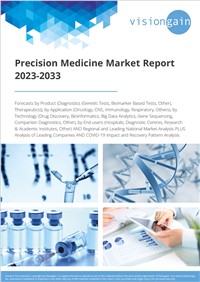The Precision Medicine Market Report 2023-2033: This report will prove invaluable to leading firms striving for new revenue pockets if they wish to better understand the industry and its underlying dynamics. It will be useful for companies that would like to expand into different industries or to expand their existing operations in a new region.
Expanding Applications of Precision Medicine and Rising Demand for Targeted Therapy
With regard to genetic disorders, precision medicine is becoming more prevalent. In the domains of neurogenetics, cardiovascular genomics, and rare illness genetic testing, this method is being employed more frequently. Additionally, non-invasive prenatal testing, pharmacogenomics, and screening genetic risk for hereditary diseases are also becoming more prevalent applications of precision medicine. A number of pharmaceutical companies are also concentrating on the creation of precision medicine for neurological conditions like Alzheimer’s and Parkinson’s disease. Pharmacological, biopharmaceutical, and pharmaceutical firms are continuously working to integrate patient-selection diagnostic frameworks into the earlier phases of drug development in order to deliver targeted therapies to the appropriate candidate and support the expansion of the precision medicine market. One of the main causes of the expanding usage of genomes and proteomics technologies as well as precision medicine is the increased understanding of the advantages of personalised medicine. Individualised treatment plans for many chronic diseases and conditions must include precision medicine, which entails the investigation of specific indications for particular medications in a given patient.
High Cost of Precision Medicine
Although personalized treatments are well-established in the pharmaceutical business, their cost continues to prevent payers, patients, and doctors from accessing them. Despite offering guaranteed returns on investment, the high initial cost of these tests makes them inaccessible to a huge majority of end users, particularly those in poor nations. As a result, end users like pharmaceutical firms, reference labs, medical facilities, and CROs who view the cost of such diagnostic procedures as a burden choose to use third-party precision diagnostic services. Inevitably, current medical privacy and investigation guidelines are inadequate to allow for the collection of enormous amounts of data on large patient populations, and private healthcare systems lack the infrastructure to do so, which drives up the price of precision medicine even more.
What Questions Should You Ask before buying a Market Research Report?
- How is the precision medicine market evolving?
- What is driving and restraining the precision medicine market?
- How will each point of care diagnostic submarket segment grow over the forecast period and how much revenue will these submarkets account for in 2033?
- How will the market shares for each precision medicine submarket develop from 2022 to 2033?
- What will be the main driver for the overall market from 2023 to 2033?
- Will leading precision medicine markets broadly follow the macroeconomic dynamics, or will individual national markets outperform others?
- How will the market shares of the national markets change by 2033 and which geographical region will lead the market in 2033?
- Who are the leading players and what are their prospects over the forecast period?
- What are the precision medicine projects for these leading companies?
- How will the industry evolve during the period between 2023 and 2033? What are the implications of precision medicine projects taking place now and over the next 10 years?
- Is there a greater need for product commercialisation to further scale the precision medicine market?
- Where is the precision medicine market heading and how can you ensure you are at the forefront of the market?
- What are the best investment options for new product and service lines?
- What are the key prospects for moving companies into a new growth path and C-suite?
You need to discover how this will impact the Precision Medicine market today, and over the next 10 years:
- Our 347-page report provides 149 tables, 220 charts, and graphs exclusively to you.
- The report highlights key lucrative areas in the industry so you can target them – NOW.
- It contains in-depth analysis of global, regional and national sales and growth.
It highlights for you the key successful trends, changes and revenue projections made by your competitors.
This report tells you TODAY how the Precision Medicine market will develop in the next 10 years, and in line with the variations in COVID-19 economic recession and bounce. This market is more critical now than at any point over the last 10 years.
Forecasts to 2033 and other analyses reveal commercial prospects
- In addition to revenue forecasting to 2033, our new study provides you with recent results, growth rates, and market shares.
- You will find original analyses, with business outlooks and developments.
- Discover qualitative analyses (including market dynamics, drivers, opportunities, restraints and challenges), cost structure, impact of rising Precision Medicine prices and recent developments.
This report includes data analysis and invaluable insight into how COVID-19 will affect the industry and your company. Four COVID-19 recovery patterns and their impact, namely, “V”, “L”, “W” and “U” are discussed in this report.
Segments Covered in the Report
Product
- Diagnostic
- Genetic Tests
- Biomarker Based Tests
- Other Diagnostic Tests
- Therapeutics
Application
- Oncology
- CNS
- Immunology
- Respiratory
- Others
Technology
- Drug Discovery
- Bioinformatics
- Big Data Analytics
- Gene Sequencing
- Companion Diagnostics
- Other Technologies
End-user
- Hospitals
- Diagnostic Centres
- Research & Academic Institutes
- Other End-users




